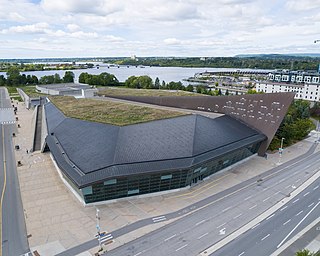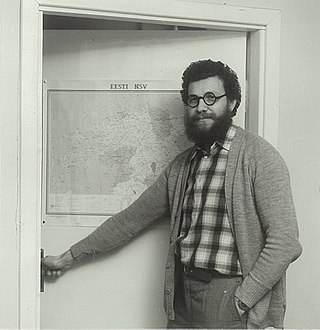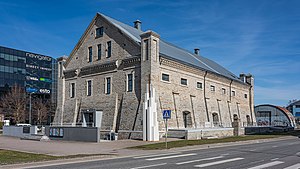
The Canadian War Museum (CWM) is a national museum on the country's military history in Ottawa, Ontario, Canada. The museum serves as both an educational facility on Canadian military history and a place of remembrance. The 40,860 square metres (439,800 sq ft) museum building is situated south of the Ottawa River in LeBreton Flats. The museum houses a number of exhibitions and memorials, in addition to a cafeteria, theatre, curatorial and conservation spaces, as well as storage space. The building also houses the Military History Research Centre, the museum's library and archives.

The Wolfsonian–Florida International University or The Wolfsonian-FIU, located in the heart of the Art Deco District of Miami Beach, Florida, is a museum, library and research center that uses its collection to illustrate the persuasive power of art and design. For fifteen years, The Wolfsonian has been a division within Florida International University.

Edgar Johan Kuusik was an Estonian architect and furniture and interior designer.
Ernst Gustav Kühnert was a Baltic German architect and art historian in Estonia.
Raine Karp is an Estonian architect.

Leonhard Lapin, also known under the pseudonym Albert Trapeež, was an Estonian architect, artist, architecture historian, and poet.
The Art Museum of Estonia was established in 1919. Originally based in Kadriorg Palace, the museum has expanded across several sites and today exhibits both international and local art works. At the end of the 1970s, in the 1980s the first branches of the Art Museum of Estonia were founded. Starting in 1995, all of the branches offer different educational programmes for children and young people. In 1996, the exhibition hall on the first floor of Rotermann Salt Storage was opened; this branch was closed in May 2005.
Tomomi Hayashi is a Japanese-Estonian architect.
Emil Urbel is an Estonian architect.
Tio Tepandi is an Estonian artist. She was born in Lüganuse, Estonia. Her grandfather was a gardener of the local estate. The memories of her birthplace, its beauty and harmony have always accompanied and influenced the artist.
Valve Pormeisternée Ulm was an Estonian landscape architect who became an architect. She was one of the first women to influence the development of Estonian architecture, becoming one of the country's most inventive modernisers of rural architecture in the 1960s and 1970s. She is often known as the "Grand Old Lady" of Estonian architecture.

Mall Nukke is an Estonian artist. A printmaker by training, she is primarily known for her paintings, collages and installations influenced by pop art. Mall Nukke emerged on the Estonian art scene in the early 1990s, her work at the period can be seen as commentary of nascent mass culture and consumer society in newly independent Estonia. Her early collages combined various cultural references and created new media characters based on real entertainers and public figures. Since the 2000s, Mall Nukke has concentrated on creating photo-manipulations and mixed media paintings inspired by Eastern Orthodox icon art.

The Alvar Aalto Museum is a Finnish museum operating in two cities, Jyväskylä and Helsinki, in two locations each, dedicated to architect and designer Alvar Aalto. All four locations are open to the public. They are:

The Estonian Museum of Natural History is the Estonian national museum for natural history. It is situated in Tallinn's Old Town.
Ain Padrik is an Estonian architect.
Anton Lembit Soans was an Estonian architect, urban planner and lecturer. He was one of the founding members of the Estonian Architects Union.

Tiit Kaljundi was an Estonian architect and a member of the Tallinn School. He became well known in the later part of the 1970s as a part of a new movement of Estonian architects that was led by Leonhard Lapin and Vilen Künnapu. The majority of the architects in this movement were graduates from the State Art Institute in the early 1970s. This group included Kaljundi, Avo-Himm Looveer, Ain Padrik, Jüri Okas, and Ignar Fjuk, as well as Veljo Kaasik and Toomas Rein from an older generation of architects. After the 1983 exhibition in the Tallinn Art Salon, they became known as the “Tallinn Ten" or the "Tallinn School," a broader term to describe the group used by the Finnish architect Markku Komonen.
Väino Tamm was an Estonian interior designer, vice associate professor in ERKI in from 1959 and interior design department manager in 1968–1986, from 1970 he was the associate professor of the interior design department in ERKI. He was one of the firsts to pave the way to the interior design department as we know it today. Väino Tamm changed the spatial design profession into a subject that deals with problems involving interior design and instead of decorating the space on the contrary dealing with arranging it. Also dealing with an overall effect and the room's whole impact on a person.
Vello (Ergav-Vello) Asi was an Estonian interior architect, graphic designer and professor at the Estonian Academy of Arts. Together with Väino Tamm, he has been one of the most important interior architects and representer of modernist interiors in Estonia since the late 1950s.

Arne Maasik is an Estonian architect and photographer. In his artwork he focuses on architectural photography.










